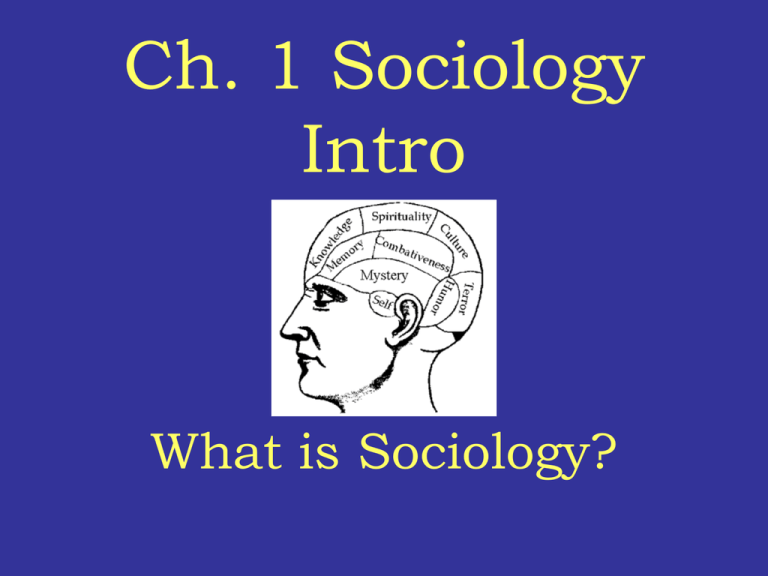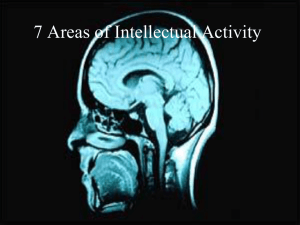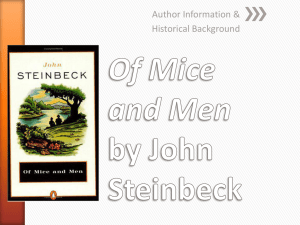Ch. 1 New What is Soc
advertisement

Ch. 1 Sociology Intro What is Sociology? I. Sociology • A. Sociology is the study of human society, including both social action and social organization B. Sociological Imagination • Sociology Imagination is a way of looking at our world in light of what is going on in the social world around us • Social = two or more people or organizations interacting Crime? Art? How do we decide? II. Key Concepts in Soc 1. 2. 3. 4. 5. Social Structure Social Action Functional Integration Power Culture A. Social Structure Def: Refers to patterns of social relationships, social positions, and numbers of people in a society. Ex. Who gets what jobs, Size of country, # of teenagers in this school A. Social Structure It’s the overarching characteristics of an institution - details may change, but the structure stays B. Social Action - Actions people consciously take in response to, coordinated with, or towards actions of other people - They’re not accidental - They must include other people C. Functional Integration The interdependence among different parts of a social system ex. Each part of a school working together C. Functional Integration A system is integrated to the extent that all the parts provide one another with the goods, services, and support they need D. Power The capacity of one social actor (a person, group, or organization) to get others to do its will, or to ensure that it will benefit from the actions of others D. Power - Conflict: A clash of powers - Lesson for life: People or groups with power will do almost anything to keep power, even if they don’t realize they’re doing it E. Culture The language, norms, values, beliefs, knowledge, and symbols that make up a way of life - The distinctive life of a nation or people E. Culture Subculture: A part of a culture that is particularly distinctive and set apart from the rest Poster 1. This needs to be colorful, look good, and show effort! 2. Title: Five themes of Sociology 3. Draw a picture to represent each theme from your life 4. Label each theme (title) 5. In your own words in at least 2 complete sentences explain each theme History of Sociology I. Modernism (18th and 19th cent.) 1. It’s the idea that everything could be figured out with science 2. Revolution: A rapid change in society - American and French Revolutions - Industrial Revolution - These led people to study the social world scientifically II. August Comte (1798-1857) 1. “Father of Sociology” 2. Decided to make the science that would include and sum up all others and came up with Soc III. Sociology as Science 1.Empirical Evidence: - Come up with theories - Test theories through observation - Polls, Surveys, Asking people questions, Observe people in situations, etc Quantitative and Qualitative 1.Quantitative Research: - Can be measured with math - Uses statistics and graphs - Measures what and where 2. Qualitative Research: - Measures WHY - Uses interviews, discussion and observation - Not easily measured with math IV. Sociological Theories A. Rational-Choice Theory 1.Adam Smith (1723-1790) - Cost/benefit thinking is basis for decisions - Culture can hinder rational decisions Rational-Choice Theory 2. Jeremy Bentham (1748-1832) - People are motivated to obtain pleasure and avoid pain - Public Good = the greatest good at the lowest cost for the most people KEY IDEA: Focuses on individual choices Jeremy Bentham B. Class Conflict and Capitalism 1.Karl Marx - Founder of Communism - Bourgeoisie: Own factories, exploit workers - Proletariat: Workers, will unite to overthrow owners B. Class Conflict and Capitalism - Class Conflict is the engine of change in history - 2 KEY IDEAS: - Society is unequal - People can gain power by socially organizing C. Max Weber (1864-1920) 1. He Focused on Social Action and Power 2. He studies individuals instead of society as a whole 3. He Disagreed with Marx 4. Individuals care more about Status Groups than economic power (I.e. people want to fit in and be better than other groups) Status groups at East? D. Functional Integration 1. Emile Durkheim (1858-1917) - Social Solidarity: Forces that bind people together - Functional Integration is the key to binding people together – each person or group does their job D. Functional Integration - Mechanical Solidarity: Shared beliefs, values, and customs in farming communities - Organic Solidarity: Based on complex divisions of labor in large societies KEY IDEA: Functional Integration How do these societies function differently? E. Symbolic Interactionism 1.George Herbert Mead (1863-1931) 2.Interactionism: How people communicate face to face E. Symbolic Interactionism 3. People construct their own social reality - Human behavior is not determined by social facts, but how they define a situation 4. We learn our place in the world through Social Interaction E. Symbolic Interactionism 5. Symbols: facial expressions, gestures, etc. 6. We base our identity on what we think others think of us KEY IDEA: Social Interaction How do you know what these mean? F. Other Important People 1. Harriet Martineau – Conducted studies on American society and set several standards for sociological studies 2. W.E.B. Du Bois – Pointed out that race was an issue that needed to be addressed (founded NAACP) W.E.B. Du Bois F. Other Important People 3. Jane Addams – believed that in order to solve the problems of poverty, you have to study poverty 4. Each of these believed that studying society should be accompanied by action to help society IV. Modern Perspectives on Sociology 1. Functionalist Perspective - Focuses on Functional Integration and Social Structure - Society runs because each part works together to produce a stable social system - Dysfunction: a negative consequence an element has for the stability of a social system -Contributors: Durkheim IV. Modern Perspectives on Sociology 2. Conflict Perspective - Focuses on competition and change in society - Looks at how those who have more power exercise control over those who have less power - Power and conflict are key - Contributors: Marx and Weber IV. Modern Perspectives on Sociology 3. Interactionist Perspective - Focuses on how individuals interact with one another - Symbols are vital - We get our identity from what others think - Contributors: Mead and Weber Poster 1. In pairs read Ch. 1.3 2. Title: Modern Perspectives on Sociology 3. Draw a picture to represent each perspective (3) 4. Label each perspective (title) 5. In your own words, using at least 2 complete sentences, explain each perspective. Skits 1. Get into 3 groups 2. Use Ch. 1 sect. 3, or your notes for information about the 3 Modern Perspectives of Sociology. (Functioinalist, Conflict, Interactionist) 3. As a group, come up with a 1 minute skit to demonstrate one of the modern perspectives (no script needed) Sources • http://healeylibrary.wikispaces.com/space/sho wimage/sociologylab.jpg • http://www.arts.ualberta.ca/~aoki/Teaching/T eaching%20Sociology/brain2.gif • http://ecx.imagesamazon.com/images/I/51mgz4btqlL._SL500_ AA240_.jpg • http://www.smh.com.au/ffximage/2005/06/30/ poverty_wideweb__430x387.jpg • http://images.google.com/imgres?imgurl=http://a.abcnews.com/images/GMA/rn_motely_060727_ssh.jpg&i mgrefurl=http://a.abcnews.com/GMA/SummerConcert/popup%3Fid%3D2242735&h=411&w=531&sz=45&hl =en&start=6&usg=__xv2EBS3_Jc8rYuwJLn73p-d-YoY=&tbnid=1jFRNhd-oMymM:&tbnh=102&tbnw=132&prev=/images%3Fq%3D80%2527s%26gbv%3D2%26hl%3Den%26client%3 Dfirefox-a%26rls%3Dorg.mozilla:en-US:official%26sa%3DG Sources • http://images.google.com/imgres?imgurl=http://mhslibrary.org/Teacher%2520Projects/Teacher%2520Projects /Social%2520Studies/D%27Acquisto/Industrial%2520Revolution/childworker.jpg&imgrefurl=http://mhslibrary.o rg/Teacher%2520Projects/Teacher%2520Projects/Social%2520Studies/D%27Acquisto/Industrial%2520Revol ution/homepage.htm&h=463&w=497&sz=38&hl=en&start=16&usg=__tH0D6cFt6A95M6FA3keDqOEaMc0=&t bnid=ypJLTVU3GFPNuM:&tbnh=121&tbnw=130&prev=/images%3Fq%3Dindustrial%2Brevolution%26gbv%3 D2%26hl%3Den%26client%3Dfirefox-a%26rls%3Dorg.mozilla:en-US:official%26sa%3DG • http://amoslanka.files.wordpress.com/2008/04/frenchrevolution-2.jpg • http://3mpub.com/carper/images/bunkerhill-small.jpg • http://mathmomblog.files.wordpress.com/2008/01/mat h02.gif • http://www.sil.si.edu/digitalcollections/hst/scientificidentity/fullsize/SIL14-L001-01a.jpg • http://www.undergradcatalog.registrar.vt.edu/0607/lah s/images/sociology.jpg • http://geraldmassey.org.uk/jones/images/karl_marx.jpg Sources • http://www.essex.ac.uk/sociology/prosp ective/research_degrees/study.jpg • http://www.graffitiarts.cn/graffitiart/Graffit i-design-11.png • http://upload.wikimedia.org/wikipedia/co mmons/0/01/Jaipur_inner_city.jpg • http://homepage.newschool.edu/het//pro files/image/bentham.jpg Sources • http://thebreakthrough.org/blog/2008/04/ 14/steel%20workers.jpg • http://turbo.inquisitr.com/wpcontent/2009/12/robbers.png • http://www.marxists.org/subject/art/visu al_arts/painting/exhibits/socialistrealism/steel-workers.jpg • http://thundafunda.com/5/5.2/women-inlaos-green-nature-farming-clm-mindpeace-pictures.jpg • http://www.faculty.fairfield.edu/faculty/ho dgson/Courses/so191/Projects2007/Bor ello/October16/mexico-city.jpg • http://www.acraftphoto.com/blogger/200 8/2008.12.19.bball.499.jpg • http://fc05.deviantart.net/fs40/f/2009/01 7/3/f/Break_Dance_by_K_RiM_Startime s2.jpg • http://2.bp.blogspot.com/_tA4rHG5B_Js /SdG8L4B380I/AAAAAAAAAk4/yZptwXl QhKA/s320/250px-Skaters1.jpg • http://www.cornell.edu/img/studentlife/2008/breakDance510x320.jpg • http://www.billwomelsdorf.com/Images/Baby%20Frown.jpg • http://farm1.static.flickr.com/96/221988958_7a4cab7d9a.jpg • http://www.mentalhelp.net/images/root/sad_black_woman.JPG • http://www.nps.gov/hafe/historyculture/images/dubois285.jpg • http://www.esaudio.net/Spanish/interaction.jpg • http://www.x-factorsolutions.com/images/conflict.png • http://static.howstuffworks.com/gif/houston-city-guide-ga-1a.jpg






